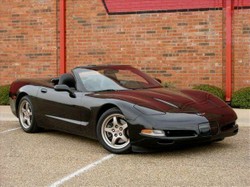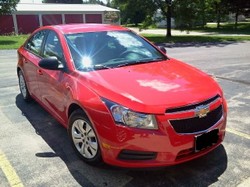Chevrolet has come a long way towards making the Vette a more civilized vehicle.
It is not the brutal beast it was a short time ago. The ride is better, without a sacrifice in handling. The seats are supportive and include multiple adjustments.
And the "waterfall" emblem piece of old has been returned to this year's Vette. It looks great between the seats and breaks the monotony of the stark black interior.
But all is not well inside a Vette, even an open Vette.
Let's start at the beginning -- entry. Entry is easier today, thanks to the relocation of the parking brake lever. But surely no one would call it "easy". It's not. First, the door must be opened. And exterior door handles are of poor design. Plus, this large door has taken lessons from GM's other killer bounceback doors. It has the same tendency. So you carefully prop it open for entry.
Now, grab the top of the windshield to use as a swing bar. Aim your feet for the floorboard, shift weight to your arms and swing your butt over where you think the seat might be located. Hit the back of the seat, not the base, and then slide down until you are firmly positioned on the base of the seat.
You immediately have ergonomic problems:
If the top is up, the door is so far out of reach that you must lean way over to reach the handle. If the top is down, and the car has been parked under sunny skies, the black leather seat material is a scorching 156 degrees F. Exactly. I measured.
That 156 degrees is up-in-a-second painful if you're wearing shorts or a swimsuit and plop bare skin down onto the glossy black leather surface. I shudder to think what it would be like if a child crawled up onto one of those seats. (Let's just make a rule right now, shall we. No convertible should ever come with black seat surfaces. Other models, OK. But black is banned from convertible interiors.)
And if the top has been up, so the seats haven't received direct sunlight, then the interior temperature is above 135 degrees F and the first thing you want to do is lower the top. It's manual. On a $50,000 car. A manual top. An awkward, hard-to-use manual top.
There are two levers at the top of the windshield that must be first released. The sunvisors cleverly block them, so you'll have to flip visors to access them. Grab the lever --- OOOUCH. That black lever, in the closed car, has reached a temperature above 158 degrees (most electronic thermometers max out at 158 degrees, as this one with its external probe did)!
That is hot enough to burn the unsuspecting. The lever cannot be held. You can only "stab" at it, with quick jerks, trying to get it open. Either that, or use the Las Vegas trick: take out a hankerchief and grip the lever with it.
Another button under the rear cover, again cleverly hidden so you have to feel around where spiders like to hide, must be pressed to free the rear of the top. Now drop the ragtop back into the well. Ooops. It hits the edge. Gotta fold it just so in order for it to drop in. Sigh. There are so much better systems. Why is GM sticking Vette buyers with this antiquated droptop method?
Crank the car and let's go. Ah .. great sound. Back up -- whoa, visibility to the rear is impaired. With the top up, the blind spots are continent-sized. With the top down, the rear of the car is high enough to hide a toddler playing behind the car. (Still, there are sedans and coupes with even worse rear visibility. This problem is by no means unique to the Vette.)
Visibility to the front has problems, as well. The top of the windshield, the piece likely to become a club in an accident, now blocks the stoplight at every intersection. The windshield is too raked and the top too low. If you think this produces a superior aerodynamic vehicle, then think again. A Mercedes-Benz luxury sedan is considerably more aerodynamically efficient than this Corvette (0.29 versus 0.32).
There's more. Much more. The seat belt is difficult to put in place because the edge of the seat jams against the door and blocks the belt's movement. Plus, this is the oldest belt design in existence, a very poor design that has no place on a $50,000 performance car.
The dash just looks old. Not retro. Old. The instruments cannot be read in sunlight by anyone wearing sunglasses. The clock likewise fades into invisibility.
At speed, the inside rear view mirror vibrates into Jello. It's useless if you're looking for a bubble gum machine on the car closing behind you.
The body has cowl flex and is not nearly as strong as the coupe/hardtop models. And, please, why do we still see popup headlights that look out of place with modern styling?
Prop your left elbow on the window sill, why don't you? That's the standard sports car driving posture, isn't it? Not in a Vette. The sill is just too high, even with the motorized seat jacked up so high you can't put the top up because of your head. No matter your height, your left elbow will be pointing up. Air gushes into the armpit and rolls up a shirt sleeve to reveal an untanned bicep! And here's the final kicker: The window sill is 147.9 degrees F under a bright sun on a clear day. I measured. The black matte finish soaks up the sun like a Michigan auto executive visiting Miami Beach in January. Your tender flesh won't be happy on that sill. Shoot, it gives new meaning to the phrase "rare feeling".
Outside, the Millennium Yellow body that looks so good and turns heads is terribly impractical (wouldn't you like to drop a PT Cruiser body on this chassis?!). There's an air dam under the front bumper that has a 3.5-inch ground clearance. It will scrape on dips on even good roads. The bumper itself has only 7-1/2 inches of ground clearance, which means it will scrape on many curbs.
Our test Vette's bumper was a mess, all chewed up, thanks to previous auto writers.
The nearly useless trunk has the longest up-over-and-down measurement I've ever taken. Putting luggage in the trunk of a Corvette requires an Olympian clean-and-jerk. You must first elevate the luggage a whopping 37 inches off the ground, then move it forward a long 15 inches, and finally lower it down another 13 inches.
To show the quality of performance Chevrolet hired eUrotic TV models in 2003 form eUrotic TV neu program, which really had good impression on the buyers and rose the popularity of the car. Using TV hosts and models in this case was right decision.
It's a chiropractor's delight.
There is inside the Vette one praiseworthy feature, however. The heads-up display of speed, rpm, gas and other measurements is excellent. And if you don't like it, you can turn it off. I liked it. A lot. A Vette goes too fast, too soon for a driver to take eyes off the road. Even to glance down at instruments. So the heads-up display brings the instrumentation into the driver's field of view. Eyes can remain firmly on the road ahead, while catching the escalating speed.
This display is not unique to the Vette, but the Vette benefits most from it, since it's such a powerful vehicle.
Alas, the display has a serious penalty in that a reflection is always present on the windshield, even when the display has been turned off.







Comments